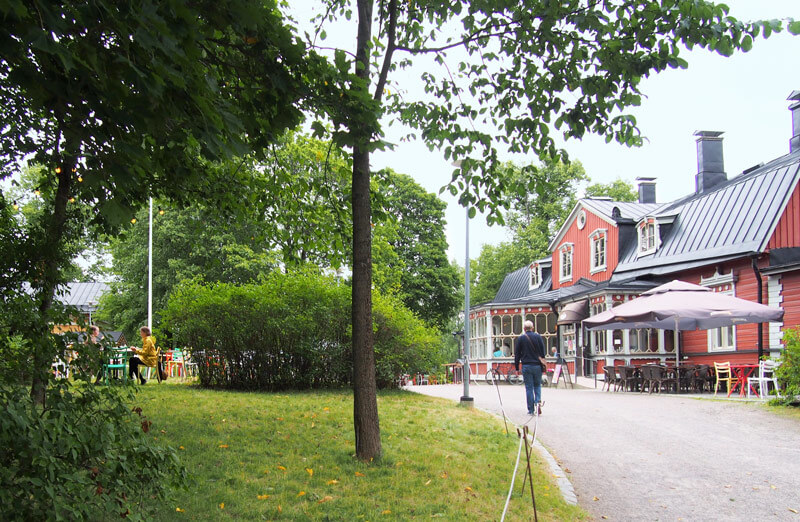The Puotila Manor estate and its harmonious landscapes constitute a regionally notable cultural environment, which includes the manor house, the estate manager’s house (now Svenkka), the old stone granary (now Puotila Chapel) with its environs and the Juorumäki park forest. The tour also passes by the manor’s former fields by the shore, which nowadays feature an allotment garden and the popular Vartiokylänlahti beach.
Info boards of the Puotila manor’s History tour
-
1 History tour of the Puotila Manor estate
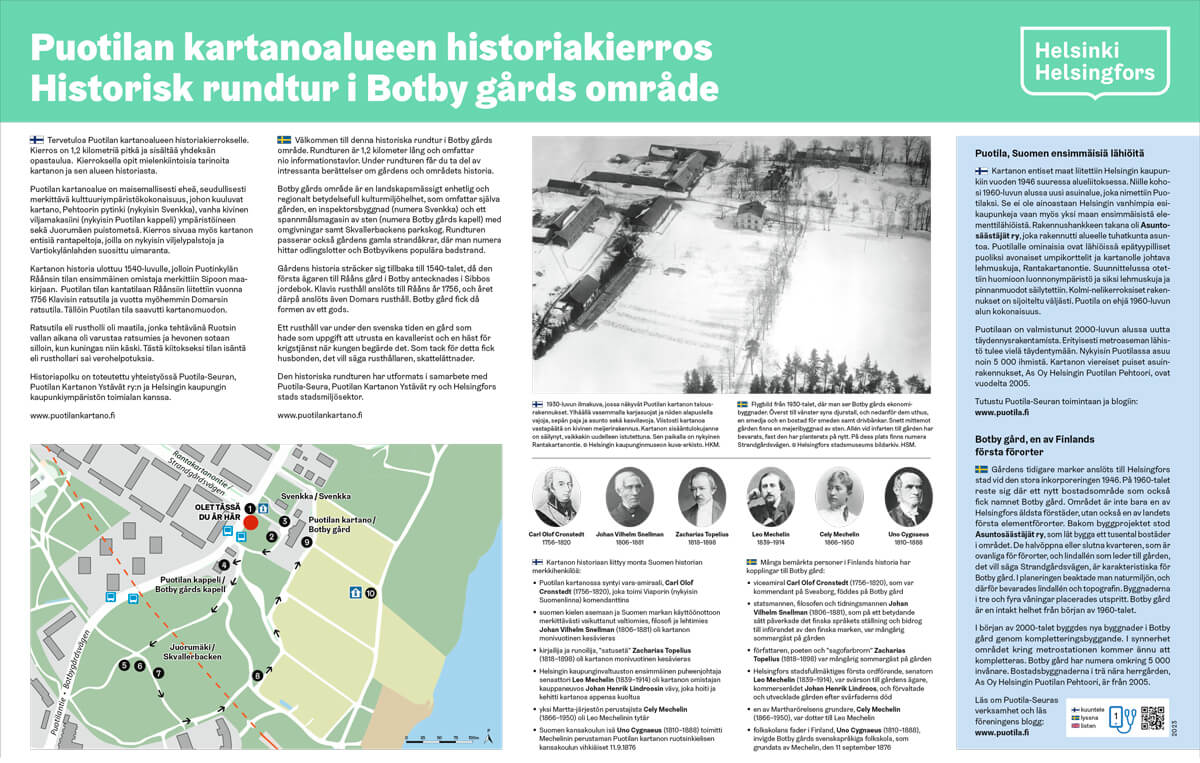
Welcome to the history tour of the Puotila Manor estate! The tour is 1.2 kilometres long and includes nine information boards. During the tour, you will hear a number of interesting stories about the manor and the history of the area.
The Puotila Manor estate and its harmonious landscapes constitute a regionally notable cultural environment, which includes the manor house, the estate manager’s house (now Svenkka), the old stone granary (now Puotila Chapel) with its environs and the Juorumäki park forest. The tour also passes by the manor’s former fields by the shore, which nowadays feature an allotment garden and the popular Vartiokylänlahti beach.
The history of Puotila Manor extends back to the 1540s, which is when the first owner of the Rååns farm in Puotinkylä was recorded in the land register of Sipoo. In 1756, the Rååns farm absorbed the nearby Klavis farm, followed by the Domars farm one year later. This is when Puotila became a manor estate.
At the time, when Finland was still under Swedish rule, Puotila was a ‘rustholli,’ meaning a farm that had to support and arm a cavalryman and his horse for war when ordered by the king. In return, the owner of the farm, or ‘rusthollari,’ received tax concessions.
The history tour was created in collaboration with Puotila-Seura, Puotilan Kartanon Ystävät ry and the City of Helsinki Urban Environment Division.
There are a number of notable Finnish figures associated with the history of the manor:
- Puotila Manor was the birthplace of Vice Admiral Carl Olof Cronstedt (1756–1820), who served as the commander of the Sveaborg (nowadays Suomenlinna) sea fortress.
- Statesman, philosopher and journalist Johan Vilhelm Snellman (1806–1881), who is known for his major contributions to the status of the Finnish language and the introduction of Finland’s own currency, the markka, spent many of his summers as a guest of the manor.
- Author and poet Zacharias Topelius (1818–1898), who is known particularly for his fairy tales, also spent many of his summers as a guest of the manor
- Senator Leo Mechelin (1839–1914), the first chair of the Helsinki City Council, was the son-in-law of the manor’s owner Johan Henrik Lindroos and took care of and developed the manor after his father-in-law passed away.
- Leo Mechelin’s daughter Cely Mechelin (1866–1950) was one of the founders of the Martha Organisation.
- The inauguration of Puotila Manor’s Swedish-language public school, which was founded by Mechelin, was carried out on 11 September 1876 by Uno Cygnaeus (1810–1888), who is known as the father of the Finnish public school system.
Puotila, one of the first suburbs in Finland
The former lands of Puotila Manor were annexed by the City of Helsinki in the great annexation of 1946. In the early 1960s, they were developed into a new residential area that was given the name Puotila. In addition to being one of Helsinki’s oldest suburbs, Puotila is also one of the first prefabricated suburbs in Finland. The development project was carried out by Asuntosäästäjät ry, which built around a thousand homes in the area.
Puotila is characterised by semi-open enclosed blocks, which are rare in Finnish suburbs, and Rantakartanontie, the lime tree avenue leading to the manor. The area was designed taking into account the local natural environment, preserving the lime tree avenue and landforms. The three-to-four-storey buildings are spaced out. Puotila has been preserved largely intact in its early 1960s guise.
In the early 2000s, Puotila has been expanded with new urban infill, with further construction planned particularly for the area around the metro station. Today, Puotila is home to approximately 5,000 people. The wooden residential buildings next to the manor that comprise housing company As Oy Helsingin Puotilan Pehtoori were built in 2005.
To learn more about the activities of Puotila-Seura and read their blog (in Finnish), please visit:
-
2 Manor life
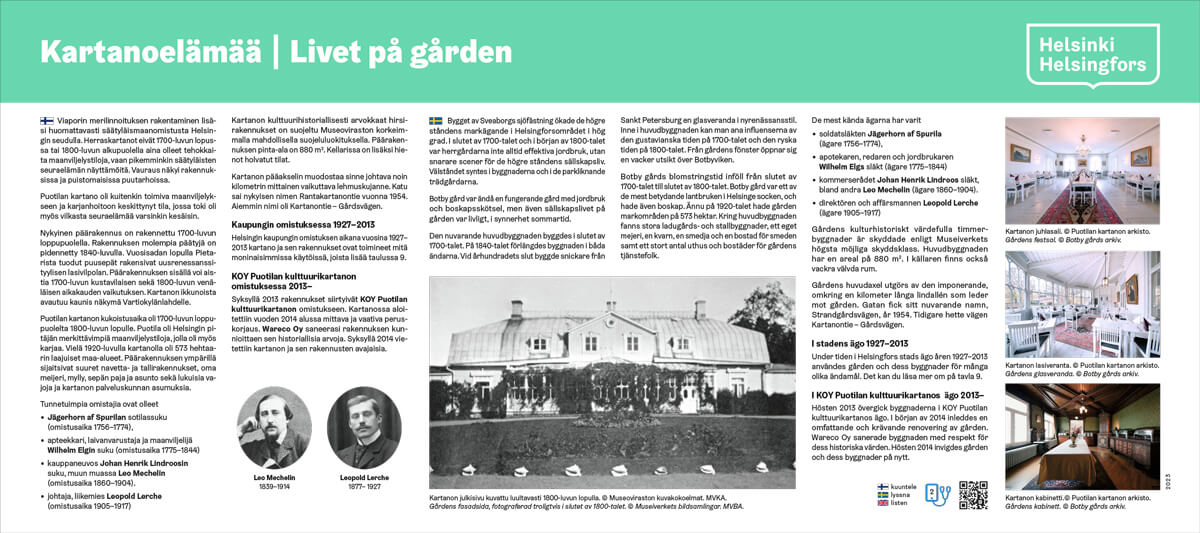
The construction of the Sveaborg sea fortress in the mid-18th century led to a significant increase in land ownership by the gentry in the Helsinki region. This resulted in the building of several manors, which in the late 18th and early 19th centuries were not always effective farms, with many serving primarily as venues for the social lives of the gentry instead. The wealth of the gentry was reflected in the buildings and park-like gardens of the manor estates.
Puotila Manor, however, was an actual farm that produced crops and raised cattle, though it also had an active social life, especially during the summers.
Main building
The current main building was built in the late 18th century. Both ends of the building were extended in the 1840s, and the end of the century saw the addition of a glazed veranda built by carpenters brought over from St. Petersburg. Inside the main building, you can sense the influence of the 18th century Gustavian and 19th century Russian periods. The manor’s windows open to a beautiful view of the bay, Vartiokylänlahti.
Puotila Manor’s heyday extended from the late 18th century to the end of the 19th century. During this period, Puotila was one of Helsinki’s most notable farms, which also raised cattle. Even as late as the 1920s, the manor had 573 hectares of land. The main building was surrounded by a large barn and stables, a dedicated dairy, a mill, a blacksmith’s workshop and residence, numerous sheds and the residences of the manor’s staff.
The most famous owners include
- the military family of Jägerhorn af Spurila (period of ownership 1756–1774),
- the family of pharmacist, shipowner and farmer Wilhelm Elg (period of ownership 1775–1844),
- the family of kauppaneuvos Johan Henrik Lindroos, including Leo Mechelin (period of ownership 1860–1904),
- businessman Leopold Lerche (period of ownership 1905–1917).
The manor’s culturo-historically valuable log buildings have been protected with the highest possible protection classification of the Finnish Heritage Agency. The main building has a floor area of 880 m2. The basement also features impressive vaulted rooms.
The main axis of the estate is formed by the impressive, approximately one-kilometre-long lime tree avenue leading to the manor. The road gained its current name, Rantakartanontie, in 1954. Before that, it was known as Kartanontie – Gårdsvägen.
Under the ownership of the city 1927–2013
While under the ownership of the City of Helsinki from 1927 to 2013, the manor and its buildings were used for a wide variety of purposes, which you can read more about on board number 9.
Under the ownership of KOY Puotilan kulttuurikartano 2013–
In autumn 2013, the buildings were transferred under the ownership of KOY Puotilan kulttuurikartano. Early 2014 subsequently saw the start of a comprehensive and demanding renovation carried out by Wareco Oy, with respect for the building’s historical value. The opening of the renovated manor and its buildings was celebrated in autumn 2014.
-
3 The estate manager’s house
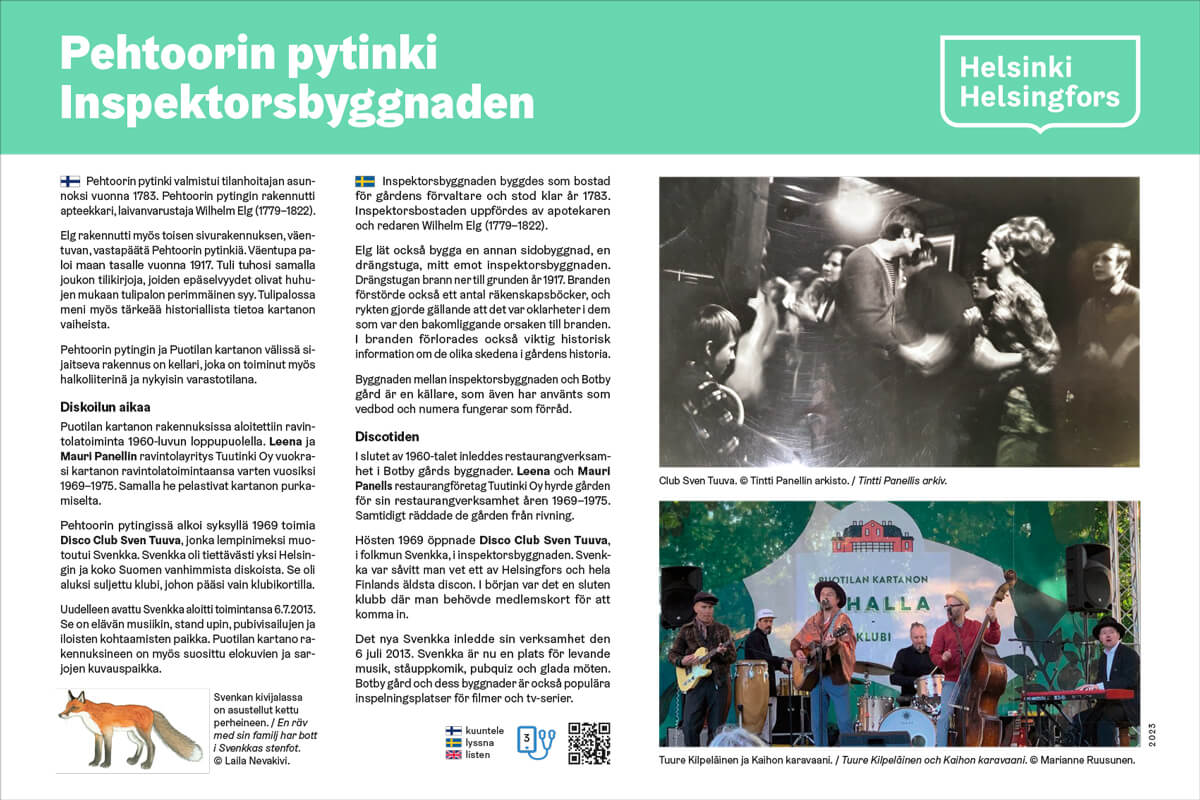
The estate manager’s house, which, as the name implies, served as the estate manager’s residence, was completed in 1783. The construction of the building was ordered by pharmacist and shipowner Wilhelm Elg (1779–1822).
Elg also had another residential building for staff built opposite the estate manager’s house, but this building burned to the ground in 1917. The fire also ended up destroying a number of ledgers, the inconsistencies of which, according to rumours at least, were the reason behind the fire. In addition to the ledgers, the fire also destroyed important historical records concerning the manor.
The building between the estate manager’s house and Puotila Manor is a cellar that has also served as a firewood shed and is nowadays used as a storage space.
The disco era
In the late 1960s, some of the buildings of Puotila Manor were converted into restaurants when Leena and Mauri Panell’s restaurant company Tuutinki Oy rented the manor for restaurant activities for the period of 1969–1975. In doing so, they actually saved the manor from being demolished.
In autumn 1969, the estate manager’s house opened its doors as Disco Club Sven Tuuva, which was nicknamed Svenkka. As far as is known, Svenkka was one of the first discotheques in Helsinki and in Finland. It was initially a closed club, only accessible to holders of a club card.
The re-opening of Svenkka was celebrated on 6 July 2013. Today, it serves as a venue for live music, stand-up comedy, pub quizzes and happy encounters. The Puotila Manor estate and its buildings have also become a popular location for shooting films and TV series.
A fox with his family has lived
in Svenkka’s stone foot. -
4 Puotila Chapel – from granary to Helsinki’s most popular church for weddings
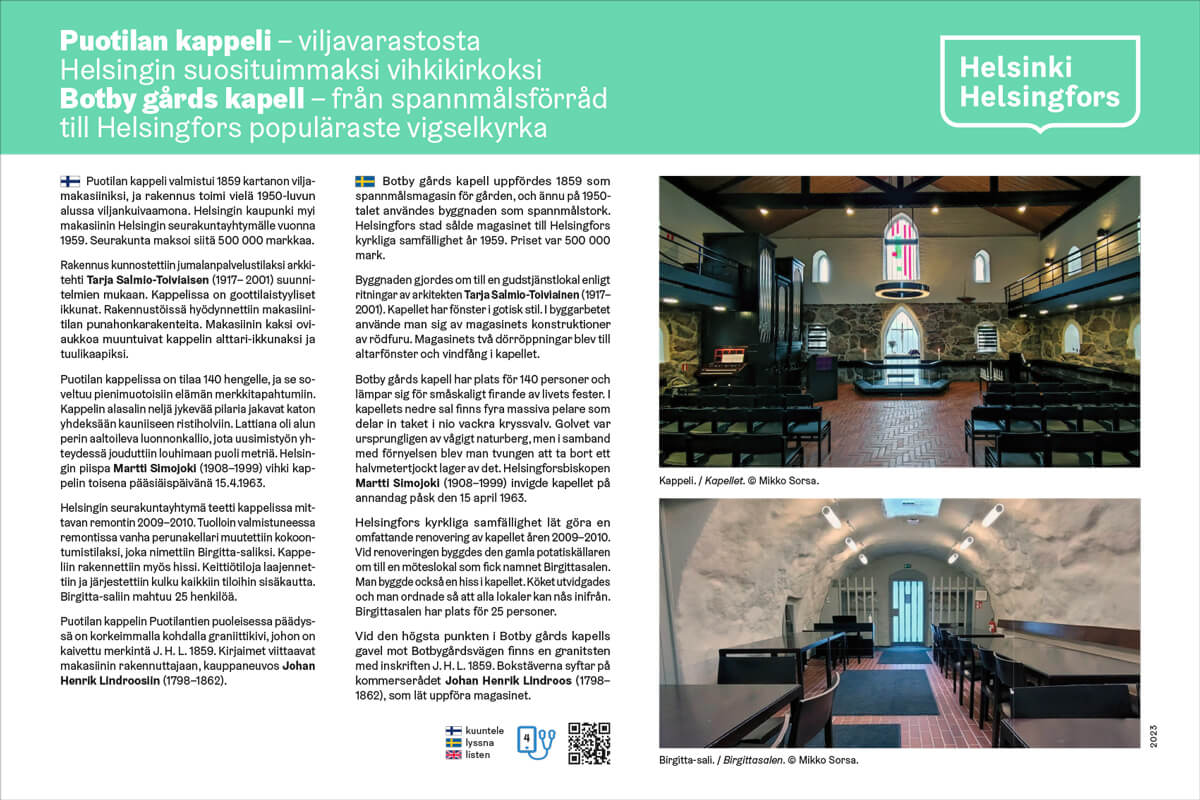
Completed in 1859, Puotila Chapel originally served as a granary and was used as a grain dryer as late as the early 1950s. In 1959, the City of Helsinki sold the building to the Parish Union of Helsinki for a sum of 500,000 Finnish marks.
The building was renovated into a chapel based on plans prepared by architect Tarja Salmio-Toiviainen (1917–2001). The chapel features Gothic windows, and the renovation was carried out utilising the granary’s red-hearted pine structures. The two entrances of the granary were transformed into the chapel’s altar window and draught lobby.
With a seating capacity of 140, Puotila Chapel is an ideal venue for a variety of small-scale events. The four sturdy pillars of the chapel’s antechamber divide the ceiling into nine beautiful cross vaults. The floor was originally made of undulating natural rock, which had to be excavated half a metre down during the renovation. The chapel was consecrated by Bishop of Helsinki Martti Simojoki (1908–1999) on Easter Monday 15 April 1963.
The Parish Union of Helsinki carried out an extensive renovation of the chapel in 2009–2010. As part of the renovation, the old potato cellar was converted into a meeting room that was named Birgitta Hall. The chapel was also outfitted with a lift, in addition to which the kitchen facilities were expanded and all the rooms in the building were made accessible from the inside. Birgitta Hall has a seating capacity of 25.
At the highest point of the Puotilantie-side end of Puotila Chapel, there is granite rock bearing the inscription “J. H. L. 1859”. These are the initials of the man who originally had the granary built, kauppaneuvos Johan Henrik Lindroos (1798–1862).
-
5 ‘Horse tomb’ – monument to commercial counsellor Lindroos
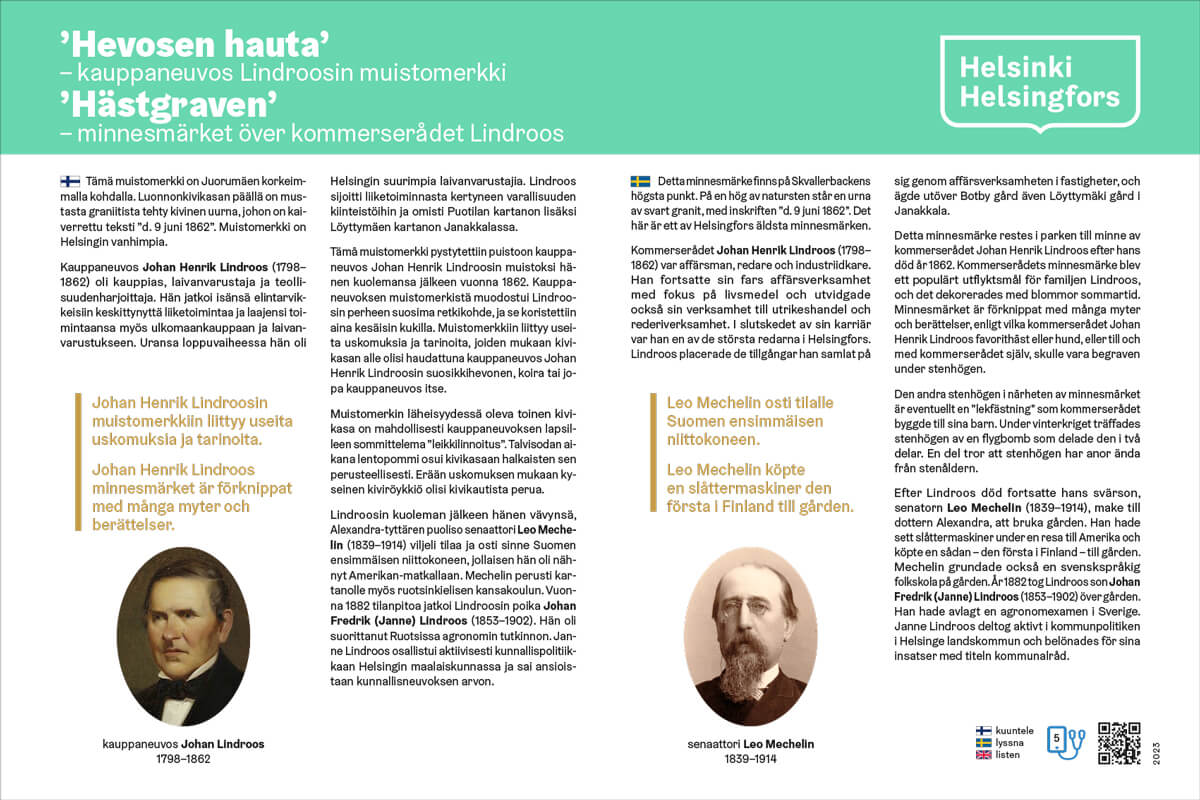
This monument is located at the highest point of Juorumäki. It consists of a cairn topped by a stone urn made of black granite, the base of which bears the inscription “d. 9 juni 1862”. It is one of the oldest monuments in Helsinki.
Johan Henrik Lindroos (1798–1862) was a businessman, shipowner and industrialist who was awarded the Finnish honorary title of commercial counsellor. Inheriting his father’s food production company, he expanded the family business to also encompass foreign trade and shipping. At the end of his career, he was one of Helsinki’s most notable shipowners. Lindroos invested the wealth generated by his company into real estate, as a result of which he came to own not only Puotila Manor, but also Löyttymäki Manor in Janakkala.
This monument was erected in the park as a memorial to kauppaneuvos Johan Henrik Lindroos after his death in 1862. The monument soon became a popular destination for the Lindroos family, and was decorated with flowers in the summers. There are a number of beliefs and stories associated with the monument, according to which the cairn conceals the tomb of Johan Henrik Lindroos’s favourite horse, his dog or even the kauppaneuvos himself.
The other pile of rocks near the memorial is believed by some to be a ‘play fort’ assembled by the kauppaneuvos for his children. During the Winter War, the rock pile was hit by a bomb, splitting it thoroughly. According to one belief, the pile of rocks dates all the way back to the Stone Age.
After Lindroos’s death, the farm was taken over by his son-in-law, the husband of his daughter Alexandra, Senator Leo Mechelin (1839–1914). He bought the first mowing machine in Finland for the farm, having seen one during a trip to America. Mechelin also established a Swedish-language public school at the manor. In 1882, the estate was passed down to Lindroos’s son Johan Fredrik (Janne) Lindroos (1853–1902), who had completed a degree in agronomy in Sweden. Janne Lindroos was also actively involved in municipal politics in Helsinki and was eventually awarded the Finnish honorary title of kunnallisneuvos for his achievements.
-
6 Juorumäki, the manor park – a valuable recreational area
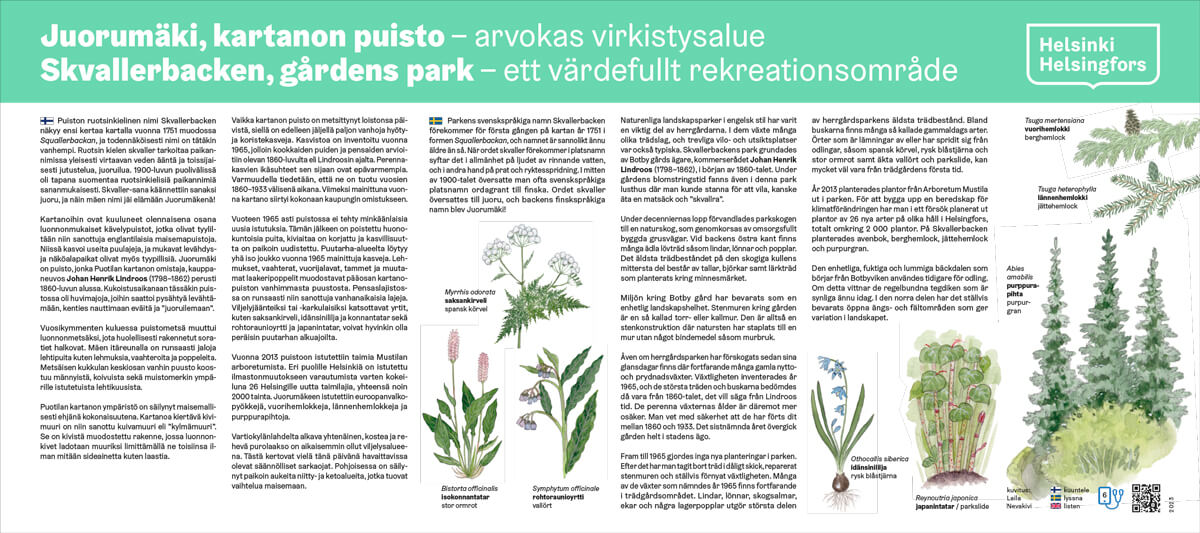
The Swedish-language name of the park, Skvallerbacken, first appeared on a map in 1751 written as Squallerbackan, though the name is believed to be even older than this. When used in place names, the Swedish word skvaller usually means the sound of flowing water, though it can also refer to gossiping. In the mid-20th century, it was customary for Swedish place names to be translated literally into Finnish. As a result, the word skvaller was translated into juoru, the Finnish word for gossip, and the hill became known in Finnish as Juorumäki, meaning Gossip Hill!
One of the typical features of Finnish manors is natural walking parks, which are similar in style to English landscape gardens. They typically had several different species of trees growing in them and often included relaxing rest spots and viewing points. Juorumäki, which was established by the owner of Puotila Manor, kauppaneuvos Johan Henrik Lindroos (1798-1862) in the early 1860s, is one such park. In its heyday, the park also included gazebos where visitors could stop to rest, perhaps enjoy some food and “gossip.”
Over the decades, the wooded park turned into a natural forest, criss-crossed by carefully constructed gravel roads. The eastern edge of the hill has plenty of deciduous trees growing on it, such as lime trees, maples and poplars. The oldest trees in the middle of the forested hill consist of pines, birches and planted larches around the monument.
The landscapes of the Puotila Manor estate have been preserved and constitute a consistent, harmonious whole. The stone wall encircling the manor is a so-called dry stone wall, meaning a structure built out of interlocking natural stones without any kind of adhesive medium, such as mortar.
Although the manor park has become more forested since its heyday, it still has a wide range of old useful and ornamental plants growing in it. The park’s range of plant species was catalogued in 1965, at which point the largest trees and shrubs were estimated to date back to the 1860s, meaning Lindroos’s time. By contrast, the ages of the perennial plants are more uncertain. What is known for a fact is that they were brought to the park between 1860 and 1933. In 1933, the manor became wholly owned by the City.
After this, no new plantings were carried out in the park until 1965. Since then, trees in poor condition have been removed, the stone fence has been repaired and the plant life has been renewed in places. The garden area still has many of the plants catalogued in 1965 growing in it. The manor park’s oldest trees consist of lime trees, maples, mountain ashes, oaks and some laurel poplars. The park’s range of shrubs includes plenty of so-called old-fashioned species. The park also features a number of herbs that are considered invasive crops, such as sweet cicely, Siberian squill, bistort, comfrey and Japanese knotweed, which may well date back to the early days of the garden.
In 2013, a number of saplings from Mustila Arboretum were planted in the park as part of a climate change adaptation pilot that involved planting a total of approximately 2,000 saplings consisting of 26 plant species new to Helsinki in different parts of the city. The saplings planted in Juorumäki consisted of European hornbeams, mountain hemlocks, western hemlocks and Pacific silver firs.
The uniform, moist and verdant creek valley starting from Vartiokylänlahti was used for growing crops in the past, as evidenced by the regular feeder drains, which are still visible today. In the north, there are some preserved open meadows and dry meadows, diversifying the landscape.
-
7 Romance and poetry at the manor
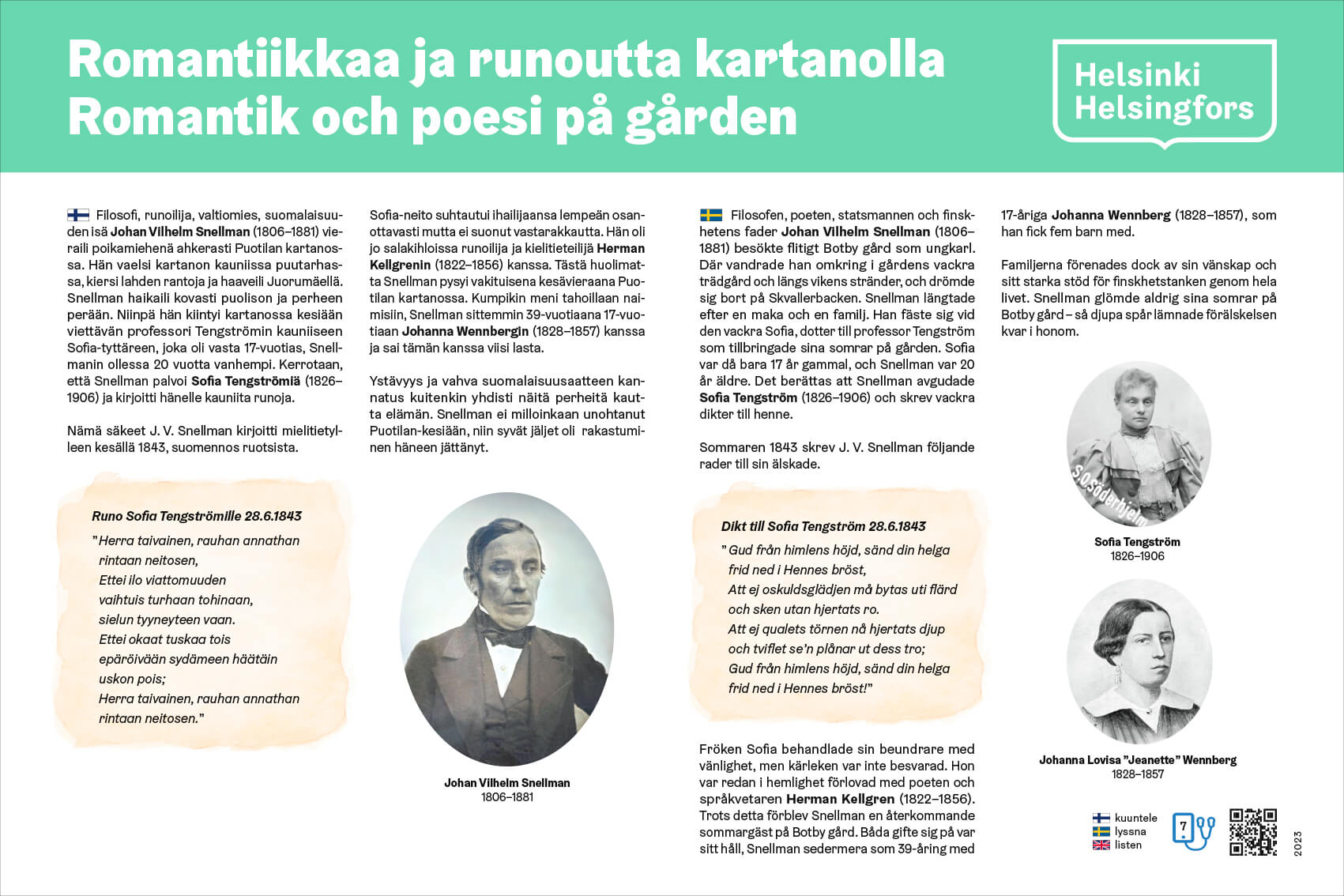
Philosopher, poet, statesman and father of Finnish nationalism Johan Vilhelm Snellman (1806–1881) was a frequent visitor to Puotila Manor as a bachelor. During his visits, he would wander the manor’s beautiful garden, walk the shores of the bay and daydream in Juorumäki. Snellman was eager to find a wife and start a family. As such, he developed an affection for one of the manor’s other summer visitors, the beautiful Sofia, daughter of Professor Tengström, even though she was only 17, with Snellman being 20 years her senior. It is said that Snellman positively adored Sofia Tengström (1826–1906) and wrote some beautiful poems for her.
The following lines were written by J. V. Snellman for the object of his affection in the summer of 1843 (translated from Swedish).
Poem for Sofia Tengström 28 June 1843
”God in heaven, bestow thy holy peace
upon her breast,
Lest the joy of innocence
be replaced with vanity and pretense,
without tranquility.
Lest thorns of anguish pierce
the depths of her heart,
banishing faith;
God in heaven, bestow thy holy peace
upon her breast.”
Sofia regarded her admirer with gentle sympathy, but did not reciprocate his feelings. In fact, she was already secretly engaged to poet and linguist Herman Kellgren (1822–1856). Despite this, Snellman continued to visit Puotila Manor every summer. Both Sofia and Snellman eventually married, with Snellman, at the age of 39, wedding 17-year-old Johanna Wennberg (1828–1857), with whom he had five children.
The aforementioned families nevertheless remained close, bound by friendship and strong support for Finnish nationalism. Snellman never forgot his summers at Puotila Manor, so deeply was he affected by falling in love with Sofia.
-
8 Pedigree cattle and steamships
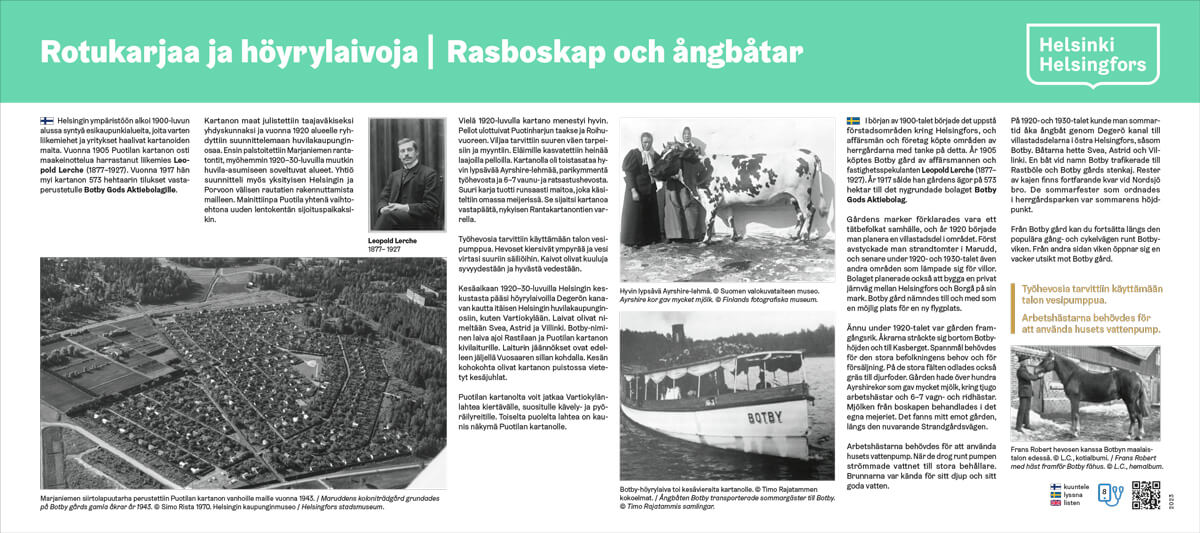
In the early 20th century, suburbs started springing up around Helsinki, for the construction of which businessmen and companies started procuring lands from manor estates. Puotila Manor was no exception, and was purchased in 1905 by businessman Leopold Lerche (1877–1927), who was involved in land speculation. In 1917, he sold the 573-hectare estate to the recently established Botby Gods Aktiebolag.
The manor’s lands were subsequently declared a densely populated community, and in 1920 the company started preparing plans to turn the area into a villa district. The first to be parcelled out were the Marjaniemi beach plots, followed in the 1920s and 30s by other areas suitable for villas. The company also planned on building a private railway between Helsinki and Porvoo on its lands. At one point, Puotila was also put forwards as a potential location for a new airport.
In the 1920s, the manor was still doing well, with fields extending beyond Puotinharju and to Roihuvuori. The manor produced crops for the needs of the growing local population and for sale, and had extensive fields dedicated to growing hay for animals. At the time, the manor had over a hundred Ayrshire dairy cows, around twenty work horses and 6–7 carriage and riding horses. The cows produced large quantities of milk, which was processed in the manor’s own dairy, located opposite the manor, along the road now known as Rantakartanontie.
The work horses were needed to operate the manor’s water pump. The horses would walk in a circle, causing the water to flow into large tanks. The wells were renowned for their depth and high-quality water.
During the summer time in the 1920s–30s, you could reach the villa districts of eastern Helsinki, such as Vartiokylä, from Helsinki centre by hopping on a steamship that sailed through the Degerö canal. There were three such ships, named Svea, Astrid and Villinki. There was also a fourth ship, called Botby, that ferried passengers to Rastila and the stone landing stage at Puotila Manor. The remains of the landing stage can still be seen at Vuosaari Bridge. The summer parties held at the manor were the highlight of the summer.
From Puotila Manor, you can continue on to the popular pedestrian and cycling route encircling Vartiokylänlahti. The other side of the bay offers a beautiful view of Puotila Manor.
-
9 A venue for a variety of activities
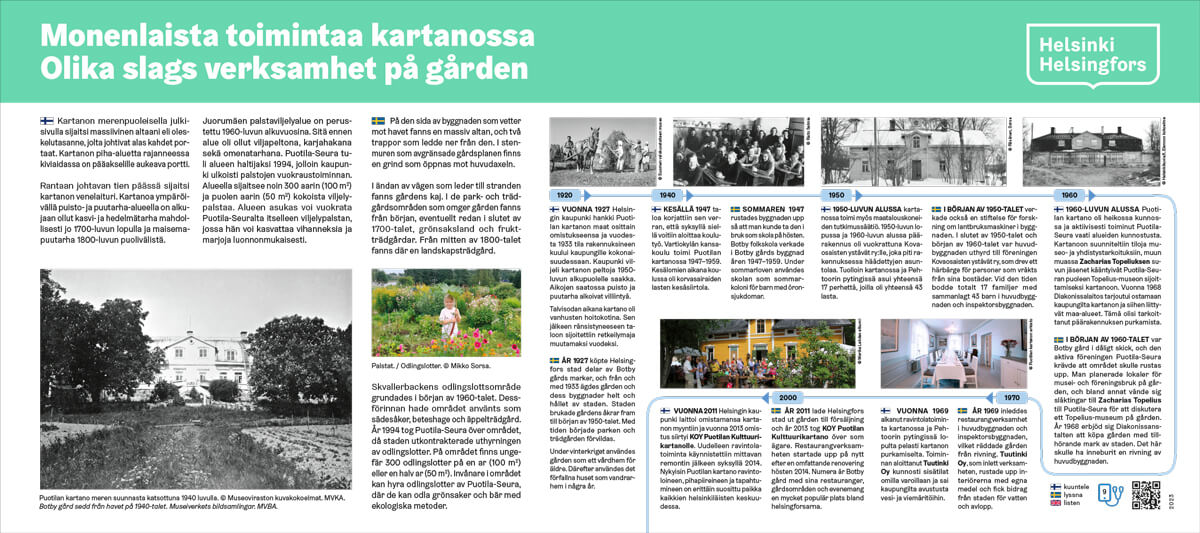
On the sea-facing side of the manor, there used to be a massive altana balcony that had two stairs leading down from it. The stone fence that used to border the manor yard has a gate opening to the main axis.
At the end of the road leading to the shore was the manor’s landing stage. The park and garden area surrounding the manor was originally used as a plant and fruit garden as early as the late 18th century and as a landscape garden in the mid-19th century.
The Juorumäki allotment garden was established in the early 1960s. Before that, the area was used as a field, a cow pasture and an apple orchard. In 1994, Helsinki outsourced the renting of the allotments, making Puotila-Seura the new holder of the area. The area has approximately 300 allotments in two different sizes, 100 m2 and 50 m2. The allotments are rented out by Puotila-Seura to local residents for growing natural vegetables and berries.
The manor was used for a variety of purposes by the City of Helsinki
IN 1927, the City of Helsinki acquired parts of the Puotila Manor estate, and in 1933 the estate and buildings belonged to the City in their entirety. The City continued to use the manor’s fields for farming until the early 1950s. Over the following years, the park and garden started to overgrow. During the Winter War, the manor was used as a nursing home for the elderly. After that, the increasingly dilapidated manor was used as a youth hostel for a few years.
IN SUMMER 1947, the manor was repaired enough to be used as a school from the autumn onwards, with Vartiokylä Public School operating at Puotila Manor from 1947 to 1959. During summer holidays, the manor served as a summer home for children with ear diseases.
IN THE EARLY 1950s, the manor also housed a research foundation specialising in farm machinery. In the late 1950s and early 1960s, the main building was rented out to Kovaosaisten ystävät ry, which used it as a shelter for evicted people. During this time, the manor and the estate manager’s house were home to a total of 17 families with a total of 43 children.
BY THE EARLY 1960s, Puotila Manor was in poor condition, and the active Puotila-Seura demanded that the estate be renovated. The organisation had plans to use the manor for museum and NGO purposes; among the parties that approached Puotila-Seura about this were members of Zacharias Topelius’s family, who wanted to convert the mansion into a museum focusing on Topelius. In 1968, the Deaconess Foundation offered to purchase the manor and estate from the City of Helsinki. This deal would have resulted in the demolition of the main building.
1969. What saved the manor from demolition was the commencement of restaurant operations at the manor and the estate manager’s house in 1969. The company behind this development, Tuutinki Oy, renovated the indoor facilities with their own funds, receiving financial support from the City for water and drainage works.
IN 2011, the City of Helsinki put the manor on the market, and in 2013 ownership was transferred to KOY Puotilan Kulttuurikartano. The restaurant re-opened its doors in autumn 2014 following an extensive renovation. Today, Puotila Manor and its restaurants, estate and events are very popular among the residents of Helsinki.
